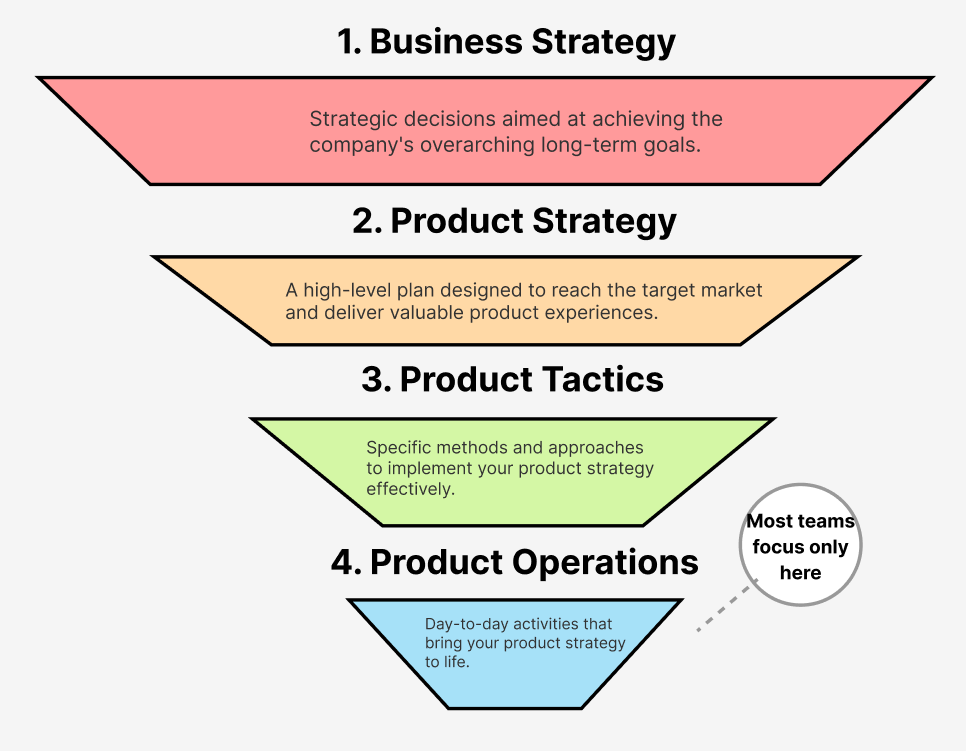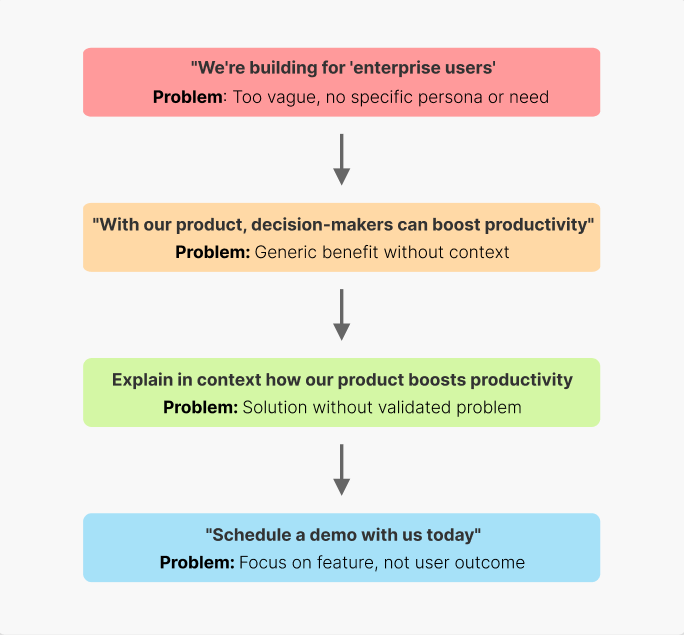Hello, welcome to this edition! 👋
Through my experience in product management, I’ve noticed a common challenge that often holds product teams back:
Skipping crucial strategic thinking and foundational work to chase feature delivery and quick wins.
So here's what you'll learn in this edition:
Why most product teams get product management wrong from day 1.
The 4 levels of product management you must master.
How to build your product strategy the right way.
Here are the four levels of product management (step-by-step explanation to follow):
Business Strategy
Product Strategy
Product Tactics
Product Operations
All successful product organizations focus on all four levels.
The problem is that people skip levels 1 and 2 to go straight for product tactics and operations.
This is not good practice. Here's why…
What happens when you skip the first two levels
Here's what it looks like when you skip through the first two levels of product management to go straight for the tactics and execution:
Building features without understanding user needs
Creating product roadmaps without clear business objectives
Running user research without a hypothesis to validate
Designing UX without a coherent product vision
These are all product operations without any strategic input.
Here's an example of skipping the foundations:
Because the target user is broad and undefined, the end result (feature set) is not effective.
Your problem is clarity
When you skip the strategic foundations behind your product, you're taking shots in the dark.
How can you build your product when you don't actually know what it is you're trying to achieve?
Why would users adopt your product if you don't know what problem you're even trying to solve?
What will you prioritize if you don't know who your core users are?
Clarity doesn't come to you in the middle of a sprint planning session.
You don't scream "EUREKA" and jump out your chair knowing exactly what your product should do and who should use it.
You get clarity by answering the right questions, one by one.
These steps will help you start:
1. Always start with your business strategy
Product management isn't some isolated function used to ship features and manage backlogs.
Your product must be aligned with the objectives and revenue targets of the business. (Otherwise, you have a feature factory. 🤷)
You must first figure out the base of your strategy. Your:
Revenue objectives ($10k MRR?.. $1M ARR?.. $50M/year?)
Target market (SMBs, enterprise customers, prosumers, etc.)
Value proposition (why does your customer actually need what you're building)
Mission (why are you in business? What problem are you solving in the world?)
2. Turn it into a product strategy
Once you have your business objectives clear, you must 'game plan' how to achieve them.
Some people hear the word 'strategy' and think it means creating a 50-page PRD that will never be read again.
But here's all you really need:
Product Vision: Where is your product going? What does the future look like?
Core Value Metric: What is the one metric that best captures the value users get from your product?
User Research: Dig for more than just usage data — what jobs are users hiring your product for? What are their pain points? How do they measure success? These are called jobs-to-be-done and are essential to know.
Product Roadmap: A roadmap is not a feature wish-list. Instead, develop a theme-based, quarterly/yearly plan so you can align your priorities with your business and communicate direction to stakeholders.
3. Choose product tactics accordingly
Most product initiatives fail — not because they're bad ideas — but because they're the wrong tactics for your strategy.
If your vision is "enterprise collaboration for remote teams" does it make sense to focus on consumer-style viral loops?
Maybe not.
You need to choose tactics that align with your target users and your desired positioning.
Some great questions for you to ask here are:
Does this tactic address a real user problem we've validated?
Can we execute this consistently with our current engineering resources?
Does this reinforce our product vision or distract from it?
Will this scale with our plans for growth?
Some common tactics that work well in product management include:
Opportunity solution trees: Map the relationship between desired outcomes and potential solutions to ensure you're solving the right problems.
Dual-track agile: Balance discovery (learning what to build) with delivery (building it right).
Continuous discovery: Don't just do research once. Create weekly touchpoints with users to constantly validate assumptions.
Outcome-based roadmaps: Focus on the outcomes you want to achieve rather than specific features to build.
North Star framework: Align the entire organization around a single metric that represents value delivered to users.
4. Run Operations to apply those tactics
Now that you're done answering questions and have actually laid the groundwork for your strategy, you can finally start running your product operations.
It's important here to consistently execute on your product development processes and then iterate based on the results.
Some key day-to-day operational tactics for your product team could be:
Sprint planning
Backlog refinement
User story writing
Feature specification
Release management
User testing
Analytics review
The feedback loop of success
The most important part about this 4-stage framework is that it isn't something you just do once and forget about.
Each level gives you feedback on a previous stage so you can make better choices with each iteration.
For example, suppose you've been building a new onboarding flow for months.
If your activation rates aren't improving (stage 4), perhaps your understanding of user needs isn't accurate (stage 2). So you revisit stage 2 and conduct more targeted user research. Now, when you test a new onboarding approach with a different emphasis, your activation metrics improve dramatically.
This illustrative example highlights how a problem at the operations level can be a symptom of a deeper issue at the strategic level.
As you can see, product management is an infinite game. One that, if you master it, can create a very successful product and business — just like it has for me.



